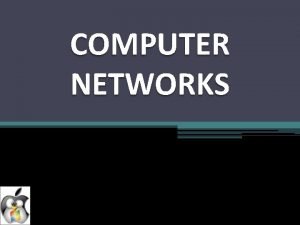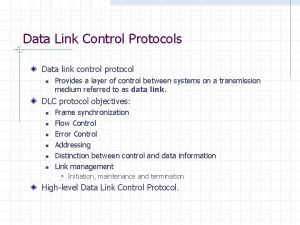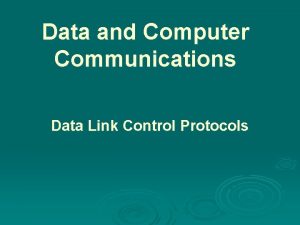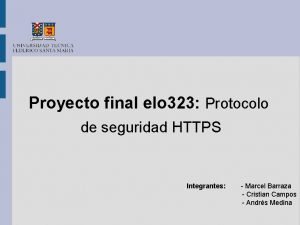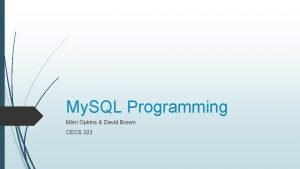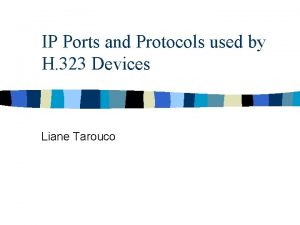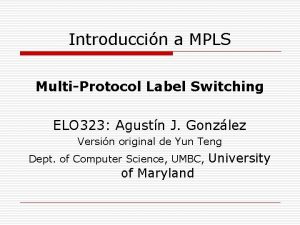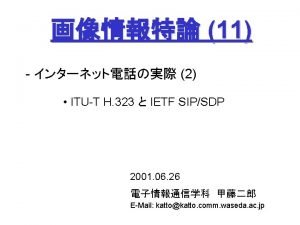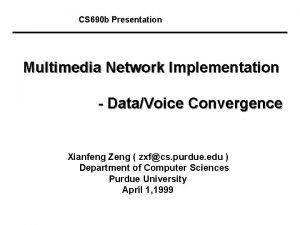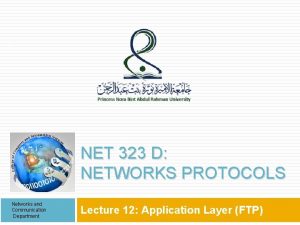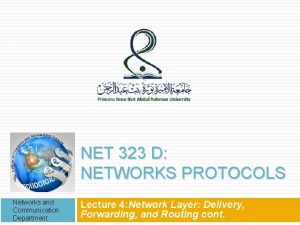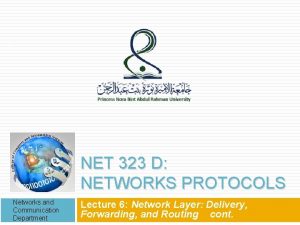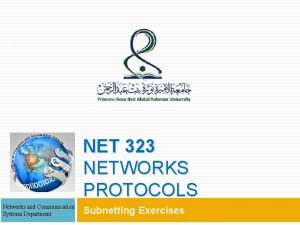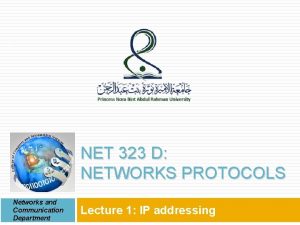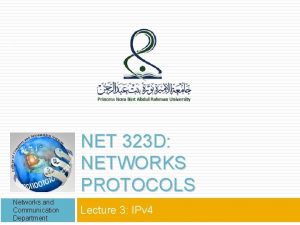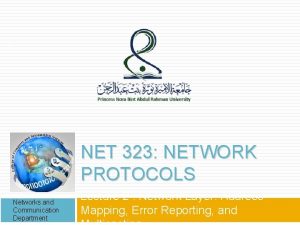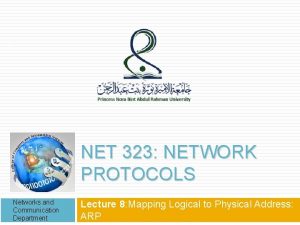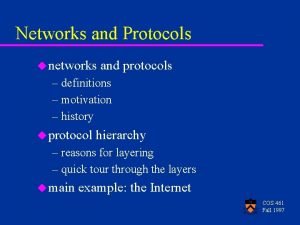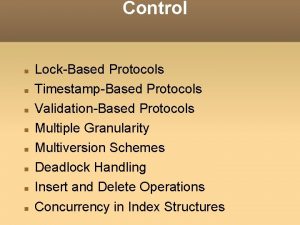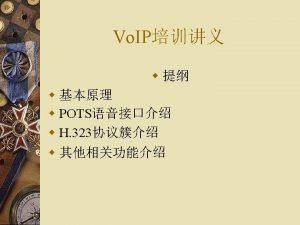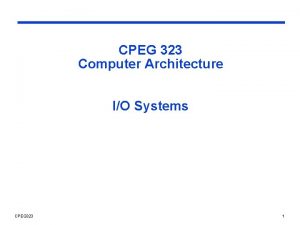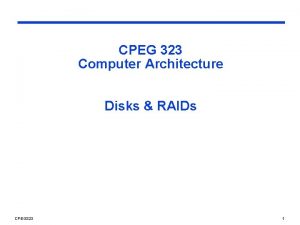1 NET 323 D NETWORKS PROTOCOLS Networks and











































- Slides: 43

1 NET 323 D: NETWORKS PROTOCOLS Networks and Communication Department Lecture 4: Network Layer: Delivery, Forwarding, and Routing cont.

Hierarchical Routing 2 To solve the problem of gigantic routing tables, we can create a sense of hierarchy in the routing tables. the Internet today has a sense of hierarchy the Internet is divided into international and national ISPs. National ISPs are divided into regional ISPs, Regional ISPs are divided into local ISPs. If the routing table has a sense of hierarchy like the Internet architecture, the routing table can decrease in size. 16 -Jan-22 Networks and Communication Department

Hierarchical Routing cont. 3 16 -Jan-22 Networks and Communication Department

Hierarchical Routing cont. 4 Let us take the case of a local ISP. A local ISP can be assigned a single, but large block of addresses with a certain prefix length. The local ISP can divide this block into smaller blocks of different sizes and can assign these to individual users and organizations, both large and small. If the block assigned to the local ISP starts with a. b. c. d/n, the ISP can create blocks starting with e. J. g. h/m, where m may vary for each customer and is greater than n. 16 -Jan-22 Networks and Communication Department

How does this reduce the size of the routing table? 5 The rest of the Internet does not have to be aware of this division. All customers of the local ISP are defined as a. b. c. d/n to the rest of the Internet. Every packet destined for one of the addresses in this large block is routed to the local ISP. There is only one entry in every router in the world for all these customers. They all belong to the same group. Of course, inside the local ISP, the router must recognize the subblocks and route the packet to the destined customer. If one of the customers is a large organization, it also can create another level of hierarchy by subnetting and dividing its subblock into smaller subblocks (or sub-subblocks). In classless routing, the levels of hierarchy are unlimited so long as we follow the rules of classless addressing. 16 -Jan-22 Networks and Communication Department

Example 22. 5 (Hierarchical Routing) 6 As an example of hierarchical routing, let us consider Figure 22. 9. A regional ISP is granted 16, 384 addresses starting from 120. 14. 64. 0. The regional ISP has decided to divide this block into four subblocks, each with 4096 addresses. Three of these subblocks are assigned to three local ISPs; the second subblock is reserved for future use. Note: that the mask for each block is /20 because the original block with mask /18 is divided into 4 blocks. 16 -Jan-22 Networks and Communication Department

Example 22. 5 (Hierarchical Routing) cont. 7 16 -Jan-22 Networks and Communication Department

Example 22. 5 (Hierarchical Routing) cont. 8 16 -Jan-22 Networks and Communication Department

Geographical Routing 9 To decrease the size of the routing table even further, we need to extend hierarchical routing to include geographical routing. We must divide the entire address space into a few large blocks. Example: We assign a block to North America, a block to Europe, a block to Asia, a block to Africa, and so on. The routers of ISPs outside Europe will have only one entry for packets to Europe in their routing tables. The routers of ISPs outside North America will have only one entry for packets to North America in their routing tables. And so on. 16 -Jan-22 Networks and Communication Department

Routing Table 10 A host or a router has a routing table with an entry for each destination, or a combination of destinations, to route IP packets. The routing table can be either q Static routing table q Dynamic routing table 16 -Jan-22 Networks and Communication Department

1. Static Routing Table 11 A static routing table contains information entered manually. The administrator enters the route for each destination into the table. When a table is created, it cannot update automatically when there is a change in the Internet. The table must be manually altered by the administrator. A static routing table can be used in a small internet that does not change very often, or in an experimental internet for troubleshooting. It is poor strategy to use a static routing table in a big internet such as the Internet. 16 -Jan-22 Networks and Communication Department

2. Dynamic Routing Table 12 A dynamic routing table is updated periodically by using one of the dynamic routing protocols such as RIP, OSPF, or BGP. Whenever there is a change in the Internet, such as a shutdown of a router or breaking of a link, the dynamic routing protocols update all the tables in the routers (and eventually in the host) automatically. The routers in a big internet such as the Internet need to be updated dynamically for efficient delivery of the IP packets. 16 -Jan-22 Networks and Communication Department

UNICAST ROUTING PROTOCOLS 13 Routing protocols have been created in response to the demand for dynamic routing tables. A routing protocol is a combination of rules and procedures that lets routers in the internet inform each other of changes. It allows routers to share whatever they know about the internet or their neighborhood. Example : The sharing of information allows a router in San Francisco to know about the failure of a network in Texas. The routing protocols also include procedures for combining information received from other routers. 16 -Jan-22 Networks and Communication Department

Optimization 14 A router receives a packet from a network and passes it to another network. A router is usually attached to several networks. When it receives a packet, to which network should it pass the packet? The decision is based on optimization: Which of the available pathways is the optimum pathway? What is the definition of the term optimum? 16 -Jan-22 Networks and Communication Department

Optimization cont. 15 One approach is to assign a cost for passing through a network we call this cost a metric. However, the metric assigned to each network depends on the type of protocol. Example 1: Some simple protocols, such as the Routing Information Protocol (RIP), treat all networks as equals. The cost of passing through a network is the same; it is one hop count. So if a packet passes through 10 networks to reach the destination, the total cost is 10 hop counts. 16 -Jan-22 Networks and Communication Department

Optimization cont. 16 Example 2: Other protocols, such as Open Shortest Path First (OSPF), allow the administrator to assign a cost for passing through a network based on the type of service required. A route through a network can have different costs (metrics). For example, if maximum throughput is the desired type of service, a satellite link has a lower metric than a fiber-optic line. On the other hand, if minimum delay is the desired type of service, a fiber-optic line has a lower metric than a satellite link. Routers use routing tables to help decide the best route. OSPF protocol allows each router to have several routing tables based on the required type of service. 16 -Jan-22 Networks and Communication Department

Optimization cont. 17 Example 3: Other protocols define the metric in a totally different way. In the Border Gateway Protocol (BGP), the criterion is the policy, which can be set by the administrator. The policy defines what paths should be chosen. 16 -Jan-22 Networks and Communication Department

Intra- and Interdomain Routing 18 Today, an internet can be so large that one routing protocol cannot handle the task of updating the routing tables of all routers. For this reason, an internet is divided into autonomous systems. An autonomous system (AS) is a group of networks and routers under the authority of a single administration. Routing inside an autonomous system is referred to as intradomain routing. Routing between autonomous systems is referred to as interdomain routing. Each autonomous system can choose one or more intradomain routing protocols to handle routing inside the autonomous system. However, only one interdomain routing protocol handles routing between autonomous systems 16 -Jan-22 Networks and Communication Department

Intra- and Interdomain Routing cont. 19 16 -Jan-22 Networks and Communication Department

Intra- and Interdomain Routing cont. 20 Several intradomain and interdomain routing protocols are in use. In this section, we cover only the most popular ones. We discuss two intradomain routing protocols: � Distance vector and � Link state. We also introduce one interdomain routing protocol: � Path 16 -Jan-22 vector Networks and Communication Department

Intra- and Interdomain Routing cont. 21 Example of intradomain routing protocols: Routing Information Protocol (RIP) is an implementation of the distance vector protocol. Open Shortest Path First (OSPF) is an implementation of the link state protocol. Example of interdomain routing protocol: Border Gateway Protocol (BGP) is an implementation of the path vector protocol. 16 -Jan-22 Networks and Communication Department

Intra- and Interdomain Routing cont. 22 16 -Jan-22 Networks and Communication Department

1. Distance Vector Routing 23 In distance vector routing, the least-cost route between any two nodes is the route with minimum distance. In this protocol, as the name implies, each node maintains a vector (table) of minimum distances to every node. The table at each node also guides the packets to the desired node by showing the next stop in the route (next-hop routing). We can think of nodes as the cities in an area and the lines as the roads connecting them A table can show a tourist the minimum distance between cities. 16 -Jan-22 Networks and Communication Department

1. Distance Vector Routing cont. 24 The tables in Figure 22. 14 are stable; each node knows how to reach any other node and the cost. 16 -Jan-22 Networks and Communication Department

1. Distance Vector Routing cont. 25 Steps : 1. Initialization 2. Sharing 3. Updating 16 -Jan-22 Networks and Communication Department

a. Initialization 26 At the beginning, however, this is not the case. Each node can know only the distance between itself and its immediate neighbors, those directly connected to it. 16 -Jan-22 Networks and Communication Department

b. Sharing 27 The whole idea of distance vector routing is the sharing of information between neighbors. Although node A does not know about node E, node C does. So if node C shares its routing table with A, node A can also know how to reach node E. On the other hand, node C does not know how to reach node D, but node A does. If node A shares its routing table with node C, node C also knows how to reach node D. In other words, nodes A and C, as immediate neighbors, can improve their routing tables if they help each other. 16 -Jan-22 Networks and Communication Department

b. Sharing cont. 28 There is only one problem How much of the table must be shared with each neighbor? A node is not aware of a neighbor's table. The best solution for each node is to send its entire table to the neighbor and let the neighbor decide what part to use and what part to discard. However, the third column of a table (next stop) is not useful for the neighbor. When the neighbor receives a table, this column needs to be replaced with the sender's name. If any of the rows can be used, the next node is the sender of the table. A node therefore can send only the first two columns of its table to any neighbor. In other words, sharing here means sharing only the first two columns. 16 -Jan-22 Networks and Communication Department

b. Sharing cont. 29 16 -Jan-22 Networks and Communication Department

3. Updating 30 When a node receives a two-column table from a neighbor, it needs to update its routing table. Updating takes three steps: 1. The receiving node needs to add the cost between itself and the sending node to each value in the second column. The logic is clear. If node C claims that its distance to a destination is x mi, and the distance between A and C is y mi, then the distance between A and that destination, via C, is x + y mi. 16 -Jan-22 Networks and Communication Department

3. Updating cont. 31 2. The receiving node needs to add the name of the sending node to each row as the third column if the receiving node uses information from any row The sending node is the next node in the route. 16 -Jan-22 Networks and Communication Department

3. Updating cont. 32 3. The receiving node needs to compare each row of its old table with the corresponding row of the modified version of the received table. If the next-node entry is different, the receiving node chooses the row with the smaller cost. If there is a tie, the old one is kept. If the next-node entry is the same, the receiving node chooses the new row. For example, suppose node C has previously advertised a route to node X with distance 3. Suppose that now there is no path between C and X; node C now advertises this route with a distance of infinity. Node A must not ignore this value even though its old entry is smaller. The old route does not exist any more. The new route has a distance of infinity. 16 -Jan-22 Networks and Communication Department

3. Updating cont. 33 16 -Jan-22 Networks and Communication Department

When to Share? 34 The question now is, When does a node send its partial routing table (only two columns) to all its immediate neighbors? The table is sent both periodically and when there is a change in the table. � Periodic Update A node sends its routing table, normally every 30 s, in a periodic update. � The period depends on the protocol that is using distance vector routing. 16 -Jan-22 Networks and Communication Department

When to Share? Cont. 35 Triggered Update : A node sends its two-column routing table to its neighbors anytime there is a change in its routing table This is called a triggered update. The change can result from the following. �A node receives a table from a neighbor, resulting in changes in its own table after updating. � A node detects some failure in the neighboring links which results in a distance change to infinity. 16 -Jan-22 Networks and Communication Department

Two-Node Loop Instability 36 A problem with distance vector routing is instability which means that a network using this protocol can become unstable. 16 -Jan-22 Networks and Communication Department

Two-Node Loop Instability cont. 37 Figure 22. 17 shows a system with three nodes. We have shown only the portions of the routing table needed for our discussion. At the beginning, both nodes A and B know how to reach node X. But suddenly, the link between A and X fails. Node A changes its table. If A can send its table to B immediately, everything is fine. However, the system becomes unstable if B sends its routing table to A before receiving A's routing table. Node A receives the update and, assuming that B has found a way to reach X, immediately updates its routing table. 16 -Jan-22 Networks and Communication Department

Two-Node Loop Instability cont. 38 Based on the triggered update strategy, A sends its new update to B. Now B thinks that something has been changed around A and updates its routing table. The cost of reaching X increases gradually until it reaches infinity. At this moment, both A and B know that X cannot be reached. However, during this time the system is not stable. Node A thinks that the route to X is via B; node B thinks that the route to X is via A. If A receives a packet destined for X, it goes to B and then comes back to A. Similarly, if B receives a packet destined for X, it goes to A and comes back to B. Packets bounce between A and B, creating a two-node loop problem. A few solutions have been proposed for instability of this kind. 16 -Jan-22 Networks and Communication Department

Solutions 39 1. Defining Infinity � The first obvious solution is to redefine infinity to a smaller number, such as 100. For our previous scenario, the system will be stable in less than 20 updates. � As a matter of fact, most implementations of the distance vector protocol define the distance between each node to be I and define 16 as infinity. � However, this means that the distance vector routing cannot be used in large systems. The size of the network, in each direction, can not exceed 15 hops. 16 -Jan-22 Networks and Communication Department

Solutions cont. 40 2. Split Horizon Another solution is called split horizon. In this strategy, instead of flooding the table through each interface, each node sends only part of its table through each interface. If, according to its table, node B thinks that the optimum route to reach X is via A, it does not need to advertise this piece of information to A; the information has come from A (A already knows). Taking information from node A, modifying it, and sending it back to node A creates the confusion. In our scenario, node B eliminates the last line of its routing table before it sends it to A. In this case, node A keeps the value of infinity as the distance to X. Later when node A sends its routing table to B, node B also corrects its routing table. The system becomes stable after the first update: both node A and B know that X is not reachable. 16 -Jan-22 Networks and Communication Department

The Routing Information Protocol (RIP) 41 It is an intradomain routing protocol used inside an autonomous system. It is a very simple protocol based on distance vector routing. 16 -Jan-22 Networks and Communication Department

The Routing Information Protocol (RIP) cont. 42 RIP implements distance vector routing directly with some considerations: In an autonomous system, we are dealing with routers and networks (links). The routers have routing tables; networks do not. � The destination in a routing table is a network, which means the first column defines a network address. � The metric used by RIP is very simple; the distance is defined as the number of links (networks) to reach the destination. For this reason, the metric in RIP is called a hop count. � Infinity is defined as 16, which means that any route in an autonomous system using RIP cannot have more than 15 hops. � The next-node column defines the address of the router to which the packet is to be sent to reach its destination. � 16 -Jan-22 Networks and Communication Department

The Routing Information Protocol (RIP) cont. 43 16 -Jan-22 Networks and Communication Department
 Protocols and standards in computer networks
Protocols and standards in computer networks Data link layer design issues in computer networks
Data link layer design issues in computer networks Elementary data link protocols in computer networks
Elementary data link protocols in computer networks Data link control
Data link control Data link control protocol
Data link control protocol Difference between virtual circuit and datagram network
Difference between virtual circuit and datagram network Basestore iptv
Basestore iptv Mgt 323
Mgt 323 Cse323
Cse323 Cos 323°
Cos 323° Le duet 198
Le duet 198 Elo-323
Elo-323 H
H Cecs 323
Cecs 323 Empire perfumes 323
Empire perfumes 323 H 323 port
H 323 port Ler router
Ler router Cos 323°
Cos 323° Internet telephony gateway
Internet telephony gateway Pc 323 barema 2020
Pc 323 barema 2020 323 economic
323 economic Cos 323
Cos 323 Cos 323°
Cos 323° Cos 323
Cos 323 Q.931
Q.931 480-323 bce
480-323 bce Cos 323
Cos 323 Icao circular
Icao circular H.323
H.323 Cos 323°
Cos 323° 323 pill
323 pill Dedálico
Dedálico Battlefords minor hockey
Battlefords minor hockey Pag 323 n 7
Pag 323 n 7 Economic 323
Economic 323 Cos 323
Cos 323 Cos 323
Cos 323 Rome 323 bc
Rome 323 bc Attestato di credito formativo dpr. 323/98 art. 13
Attestato di credito formativo dpr. 323/98 art. 13 What is h.323
What is h.323 H.323 vs sip
H.323 vs sip Cos 323
Cos 323 H.323
H.323 Sip vs mgcp
Sip vs mgcp


